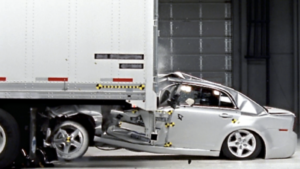Whose fault is a parking lot back-up collision? It’s a well-known fact that car crash accidents happen every day on the roads of Washington State and across America. What many drivers do not realize is that not all auto accidents happen on the road. Yes, tens of thousands of accidents occur each year in parking lots. These accidents can occur in many ways, but a frequent source of parking lot mishaps occur when one or both cars are backing up. As you can imagine, when this happens, the determination of fault can be tricky.
Right of Way
Who had the right of way? This is a key question in any driving crash situation, including parking lots. A general rule of the road is that the person who did not have the right of way is at fault for a crash, and in a parking lot, this would be the person who is backing up. We expect the driver who is backing up to monitor the situation carefully, allowing people with the right of way to pass prior to pulling out, just like when backing out of a driveway. Unless the driver with the right of way can be proven to have been negligent in some way (like being distracted by a phone or speeding), the driver who was backing up is at fault.
Another situation where it is clear who was a fault is when one of the cars involved was actually stationary when the accident occurred. If one car is stationary, then the other driver is at fault.
But what about when neither driver has the right of way – as when both cars are backing up in a parking lot? If there are extenuating circumstances that show that one driver was negligent, then that driver would be at fault. But in the absence of such extenuating circumstances, both drivers who collided while backing up would be found equally liable.
Exceptions to Right of Way
In today’s era of cell phones, car stereos, and GPS systems, there are many things that can distract a driver, and instances of this are even more prevalent when drivers are moving through a parking lot. According to the National Safety Council, 66% of drivers admit to talking on the phone while driving through parking areas. In addition, the majority of drivers surveyed also admitted to programming their GPS, texting, viewing social media, or sending and receiving emails while driving through parking lots. Parking lot surveillance cameras and witness statements could go a long way in determining who was at fault when one or both cars were backing up.
These would all be exceptions to the right of way rule discussed above. In other words, even if Driver A was backing up, if Driver B was busy programming his GPS when the collision happened, then Driver B would likely be found to have been at fault.
Inspecting the Damage
Another way of determining fault when backing up is to inspect the damage on both cars. The location of the damage to each car is important evidence that can go a long way in determining fault. Here’s an example situation:
Car A is backing out of a parking space at a busy mall and is struck by Car B as it makes its way down the parking row. Car B clearly has the right of way and would likely be determined to not be at fault. If the side of Car A was damaged, that would provide further proof that Car A pulled out in front of Car B and is at fault for the accident.
However, if Car A has a damaged back trunk, it would likely mean that Car A had completed backing up and was about to move forward when Car B hit it. In this case, it seems clear that the “backing up” had been completed, and now Car B would be held responsible for the crash. This responsibility sticks regardless of the reason Driver B ran into the back of Car A. Whether he was playing with his phone, the stereo, or simply was not paying attention, striking the rear of Car A means that Car B was at fault.
Comparative Negligence
If both cars carry some of the faults for the accident, the rules of comparative negligence would come into play when determining compensation for the accident.
States like Washington follow the rule of comparative negligence when it comes to determining compensation in an automobile accident. Comparative negligence means that compensation is diminished by each participant’s amount of fault in an accident.
Let’s take the situation above as an example. If Car A is determined to be 25% at fault and Car B is shown to be 75% at fault, then both recoveries would be lessened by their percentage of fault. So if Car A was awarded a total of $10,000 in damages, but was 25% at fault, her award would be 25% less than the $10,000 – for a final award of $7,500.
Avoiding an Accident While Backing Up
Of course, the best thing for all parties concerned is to avoid the accident altogether. When backing up, be sure that you are not distracted by talking on your cell phone or other means. Back up slowly, and consistently look around as you do so in order to watch for cars, children, or other hazards. If you do have a rear-mounted camera on your car, do not use it exclusively. It is a good tool to look for hazards before you begin to back up, but your overall vision and peripheral vision give you a much broader view of the area around you.
Parking lot collisions are frustrating. It can be difficult to determine who was at fault. Experienced legal counsel can help. Contact us today to schedule a consultation.



